|


|
|
JANUARY/FEBRUARY 2021 NEWS |
|
|
|
February 27, 2021 |
|
It's been more than 3 1/2 years since Sam Shepard left the
living world of ours and no one has even hinted at where his body or his ashes
have been laid. Was his body delivered to a funeral home or crematorium? Such a
silence. Even in death, Sam desired privacy and denied his fame. No matter where
his 'remains remain', his spirit abides in all his screen work, plays and
stories. I continue to discover new remembrances written back in the summer of
2017 at the time of his death. Today I'll share an excerpt from Dan Reidy of Men's Journal:
It only takes a glance to see that he packed several
lifetimes into one, all of them cloaked in the mystery that comes with
tight-lippedness and a penchant in his stories for mixing fiction with
autobiographical detail. He liked the road. He knew the highways of the West
as well as a long-haul trucker, and his stop-off points were no less
obscure... Shepardís characters are ghosts made flesh, cowboys out of time.
Restless, they move through towns whose names seem to tell stories of their
own: Winnemucca, Nevada; Papantla, Mexico.
* * * * *
An apt description of Sam's writing: "Had
Sam Shepard been a boxer, he may well have favored removing the gloves. His
writing has a rawness seldom matched in drama, so words become weapons that open
wounds old and new, while his characters are bruised and scarred by each other
and by the bleak business of being alive." * * * * *
And today's gift to Shepard fans is this beautiful Timothy White portrait.
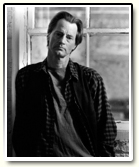 |
|
|
|
February 11, 2021 |
|
In the February 1992 issue of Rolling Stone, writer David
Breskin described an interview with Robert Altman, who directed the film
FOOL FOR LOVE, based on Sam's play. Here's
an excerpt:

Breskin: When you did "Fool for Love", you said you didnít
care if it was the worst film ever made, you were going to do it for the
opportunity to work with Sam Shepard on a play he wrote, and have him in it.
Altman; [Resigned.] Yeah, I said that. The idea of me making a film with the
author of a play, and the author playing a part, to me was irresistible. And
because I was in such a catbirdís seat. And I thought it would be fun.
Breskin:
Cheerfully perverse.
Altman: Yeah, perverse and fun. It turned out to be not much fun at all.
Breskin: You and Shepard had a tough time.
Altman; No, I didnít have too tough a time, and he didnít have a tough time. Any
tough times we had, we gave ourselves. But I didnít like him very much and he,
Iím sure, didnít like me. He just wasnít a very nice person during that time.
Breskin: And thatís why it was no fun?
Altman: Yeah. He wasnít nice. He was very self-oriented. Kim Basinger was just
terrific, Iím crazy about her. And Sam, I think, is very, very good in that
picture. As good as I wanted him to be.

Breskin: How did he end up feeling about the picture?
Altman: Oh, he would never say. Iím sure he hated it. Weíd show the dailies, and
he could come in whenever he got up ó weíd work all night ó and weíd look at the
dailies in the morning. Heíd come in late in the afternoon and weíd run the
dailies for him and heíd only look at the dailies that he was in. And of course,
all the flashback stuff, all the storytelling illustrations that I did, he, to
this day ó he says he never saw the picture, and he probably hasnít ó he didnít
know what I was doing, nor did he care, that I was showing something different
than what the characters were telling. And that, to me, that time warp in that
picture, is what made that film so good. I think that was a terrific film, I
really liked that film. I liked the structure of it, I liked the performances in
it, I just liked the picture very much. The bizarreness of it. But Sam just
wasnít very likable. I donít know why.
Sources say that Sam was never that eager to have his play
adapted to the big screen nor star in it. He believed Ed Harris, who originated the
role of 'Eddie' at the Magic Theatre in San Francisco, was a better choice.
Altman wanted to cast Jessica Lange as 'May' but she was pregnant at the time so
the role went to Basinger. And a major disappointment for Sam was that he believed he would be part of the
editing process, which never happened, so he was definitely not a happy camper.
In the September 1988 issue of Interview magazine, he
explains further - "I felt very uncomfortable. I was not having a good time. I
didn't get off on that (laughs). First of all, this was a situation I tried to
avoid for a long, long time - acting in my own stuff - because I always felt it
was silly and pretentious. You know: acted and written by and all that crap.
Appearing in! Jesus... I didn't feel comfortable with that at all... I liked
Altman's stuff up to a certain point. And I was fooled into believing that he
was going to have integrity in this thing. Later on, I just felt he kind of
shined me on. That surprised me. I just felt like he blasted through the thing
and didn't give it everything he told me he was going to give... I'm never going
to get into a situation where I have somebody else breathing down my neck. It's
just not worth it - no matter how much money they say they're going to give you.
I was very lucky on 'Far North' to get final cut and full artistic freedom."
Photographs for Interview by Herb Ritts -
"Fool for Love" did become more of a family affair when Sam's
sister Sandy Rogers was asked to participate in the soundtrack. She recalls,
"Sam called one day in April and said he'd like me to write some songs for the
movie version of his play. He had begun production in Santa Fe and had played an
old tape for Robert Altman of me singing - a tape that he'd been carrying around
for
 years
- some of my very first songs... I went immediately to the basement apartment to
write songs for the movie and got those off to Sam in three days. Sam called
back right away and said he loved them... He would submit them to Altman. Altman
loved those - and wanted more, wanted to see if I could do the whole
soundtrack." In the end, Sandy performed eight of her songs. However, her "Let's
Ride" became the title song and "Fool for Love' didn't even make the album
though it appears on the soundtrack for "Reservoir Dogs". years
- some of my very first songs... I went immediately to the basement apartment to
write songs for the movie and got those off to Sam in three days. Sam called
back right away and said he loved them... He would submit them to Altman. Altman
loved those - and wanted more, wanted to see if I could do the whole
soundtrack." In the end, Sandy performed eight of her songs. However, her "Let's
Ride" became the title song and "Fool for Love' didn't even make the album
though it appears on the soundtrack for "Reservoir Dogs".
I rather like the film's Italian poster -
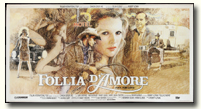
|
|
|
|
February 6, 2021 |
|
Though Sam was no longer living with partner Jessica Lange in 2009, he admits he did give her some Valentine's Day gifts the following year -
"Two really good bottles of wine. Really good ones. Oh, and a tape measure.
Because she was putting up a painting." A new
gallery has now been posted featuring the famous pair photographed by
Bruce Weber in two Vanity Fair issues - October 1984 and April 2006.
* * * * *
While Sam was in Paris with Patti Smith during the spring of
2011, he attended the Ines De La Fressange Auction Breakfast at Cafe de la Paix
on May 24th. The proceeds of the event went to Mecenat Chirurgie Cardiaque
Enfants du Monde, a charity that allows children suffering from heart
malformations to come to France and receive operations when they cannot be
treated in their home countries. These photos show Sam chatting with Ines -
French model, aristocrat, style icon, fashion designer and perfumer. [Have never
understood those sunglasses]
|
|
|
|
February 1, 2021 |
|
The November 1988 edition of Esquire magazine featured
Sam on the cover with an article by Jennifer Allen, who in later years admitted,
'I wrote a piece about Sam Shepard for Esquire. I pretended to be interested in
his work but I really wanted to know about Jessica Lange."
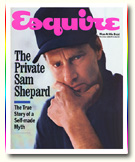
The photo shoot for the magazine was done by Bruce Weber but
not all the photos were published in Esquire. The following is the introduction
by Jennifer Allen:
He still has the tattoo on his left hand, the one he got
from a Mexican gypsy while whacked out under Patti Smithís spell. She got a
lightning bolt; he got a hawk moon because he was born under a skinny
November moon. It is a dark, pencil-thin arc on the back of his hand, and
seeing it is a jolt, like looking at an artifact, a reminder that the
forty-five-year-old man in a freshly pressed white shirt has lived several
lifetimes.
Once he lived in New York, the crazy, druggie downtown
boy genius who convulsively wrote his plays one after the other, almost as
if he had to be rid of them, to jettison them. Once he moved into the
Chelsea Hotel with Smith and, legend has it, wrote with her the screaming
sad play "Cowboy Mouth" in two nights by pushing a typewriter back and forth
across a table.
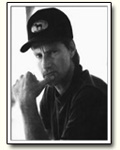
For some years now, he has sworn off cities with a
vengeance, taken to badmouthing the Sixties and the plays he wrote then. He
is a family man with three children - a son by his first marriage, two small
children by Jessica Lange - a movie actor, one of the leading playwrights of
his generation, a screenwriter, a director of his own plays and now of his
own movies.
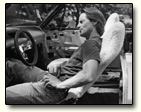
He lives on a farm twenty minutes outside a small city in
Virginia. He agrees to meet at a local inn of his choosing. He is recognized
the moment he enters, people whisper in his wake. The face is bony, sharp,
sharper with age. He has a pronounced widow's peak, straight hair falling
down on either side and stopping abruptly, as if it has been chopped by
blunt scissors. His eyes are blue, almond-shaped, his teeth are not good.
When he speaks, he often tucks in his chin just slightly, as if he would
rather swallow the words than say them. He has a soft voice with a slight
twang; he drops his g's and pronounces his name "Sam Shepurd". He smiles
often.

|
|
|
|
January 30, 2021 |
|
El Europeo magazine, published in Madrid years
ago, featured a familiar pair on its cover in its
July/August 1989 edition. However, the original Bruce
Weber portrait has been horizontally flipped.
When Sam was living in New Mexico in 1984, fashion
photographer Bruce Weber did a photo shoot with Sam and actress Jessica
Lange. One of these days I will post those photos. Weber, famous for his
stunning black & white portraits, photographed Sam through the years for
several other major publications. The following photo should look familiar
because it's the one I use at the top of this page. This is the May/June
1994 issue of Arena magazine.

* * * * *
The following photo is undated but I would venture a
guess that it was probably taken 8 to 10 years ago. It
shows Sam playing guitar with his old friend
Peter Stampfel from the Holy Modal Rounders, the band
Sam joined as a drummer back in the sixties.

When Sam died, Stampfel wrote a rather strange tribute
to Sam, mostly ramblings of a musician who perhaps had
taken too many drugs over the years. I never shared it
because it seemed to lack clarity and sometimes
accuracy. He does mention Sam's driving recalling how
he'd reassure his passengers that he was an excellent
driver and then tear off like a bat out of hell. His
daughter Hannah told Stampfel how her father would pick
her up from high school in his Corvette and take off
laying a strip of rubber.
His desire for speed did at times get him in trouble
with the law. In January 2009, he was pulled over for
speeding in Normal, Illinois, and subsequently arrested
on drunk driving. It wasn't the last time he was
intoxicated at the wheel. In 2015 in Santa Fe, New
Mexico, he was again arrested. In a press interview
conducted in 2010, he described his addiction as a
"constant struggle."
In a February 24, 2000 letter to his friend Johnny Dark,
Sam wrote about his alcoholism. It's interesting that he
made the decision to publish this letter, which was
included in the book "Two Prospectors: The Letters of
Sam Shepard and Johnny Dark", but perhaps his
decision was a cathartic one. Here's an excerpt:
"I had a hard time seeing myself in the same exact bag as
my old man, who I swore I would never resemble. In a way, the decision to
stop drinking was the easiest partóof course you go through about a three
month stretch where you body has to detox and get rid of all the poison
youíve built up and through that time thereís a lot of craving and self-pity
but then the 'need' for booze kind of leaves your physical self and the
psychological part takes over. Thatís the tough one for me because it all
has to do with this thing of loneliness and the inability to have easy
relationships with other people." "Itís the very reason I
started drinking in the first placeóthe bar, the 'Nightlife'; the excitement
of meeting strange women; the 'Adventure'óthis whole notion that thereís
something out there Iím missing out on and booze was definitely the ticket
that opened the door. The false courage that drinking gave me allowed me to
indulge any idiocy that came along with never any thought of having to pay
for it down the road." "Also, there was the 'romance' with
the bottleóI was a writer, I had a license to drink. All writers drink, even
great ones. I was a 'tough guy.' I could take it. I didnít give a shit what
anybody thought and I didnít really give a shit what I did to other people
in the way of abuse or denial. I was my own guy! Iím amazed I lived through
it actually: blackouts on the road doing ninety miles an hour, winding up
sleeping in ditches; fist fights with Marines; hangovers that went on
through half the day and were only remedied by more booze, strange women who
could have been carrying anything; pool games til the crack of dawn with
Italian Mafioso types where I lost hundreds of dollars, terrible fights with
the ones I loved; the shakes, vomiting, shitting my pants on the
streetóSounds like fun, huh?" "From the outside one might
say well, sure, it was probably time for you to take stock of yourself but I
never saw the least little part of it. I thought the world was fucked up and
I was just reacting like some kind of underground hero."
|
|
January 21, 2021 |
|
 In
2018 a Croatian translation of Sam's final book, SPY OF THE FIRST PERSON, was
published by Antipod with the translation done by Martina Klasić. The book
is called UHODA. In the last year of his life, as the degenerative
disease ALS made his muscles progressively useless, Sam finished this book
about a man suffering from a similar but unnamed illness. An unidentified
first-person narrator looks across the street at a strange man in a rocking
chair on the porch. It soon becomes clear that they are the same person, a man
observing himself from the outside, his failing body so alien that he doesnít
recognize it as his own. In
2018 a Croatian translation of Sam's final book, SPY OF THE FIRST PERSON, was
published by Antipod with the translation done by Martina Klasić. The book
is called UHODA. In the last year of his life, as the degenerative
disease ALS made his muscles progressively useless, Sam finished this book
about a man suffering from a similar but unnamed illness. An unidentified
first-person narrator looks across the street at a strange man in a rocking
chair on the porch. It soon becomes clear that they are the same person, a man
observing himself from the outside, his failing body so alien that he doesnít
recognize it as his own.
Uhoda means "care" and I suppose that references all the
loving care his family provided for him in his final weeks. According to his
sisters, when Sam was unable to hold a pen, he spoke into a voice-activated
recorder. When he could no longer hold the recorder, he dictated to his daughter
Hannah or his sisters Roxanne and Sandy, who did the transcription and read the
notes back to him. Roxanne indicated, "Sometimes he wanted to dictate things at
night before going to sleep. I kept a notebook close so that he could just ask
to write something down and it could be dictated on the spot." Sandy said, "He's
a writer so he needed to write every day to be himself, and that was our
mission, to help him be as close to normal as possible."
And Hannah added, "The line between fact and fiction in his own work was always
very ambiguous to Sam, I believe. Many things blended together for him."
Toward the end of the book Sam mentions his sons Jesse and
Walker - "The thing I remember most is being more or less helpless and the
strength of my sons. A man pushed by his sons in a wheelchair from a crowded
restaurant to a street with nobody on it. A man sitting on shaggy wool with a
Navajo blanket across his knees."
In this Croatian edition, the following two artistic illustrations represent the
beginning and end of the story. The photo of Sam was taken from a January 2016
photo shoot for The New York Times.
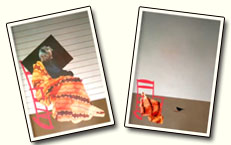
|
|
January 19, 2021 |
|
Earlier this month Sam's daughter Hannah was caught by the
paparazzi walking in Manhattan's West Village on a cold day.
Since her father's death, Hannah has worked as an archival
producer on three documentaries that focus on racism and justice. The Women in
Media web site gave the following biography:
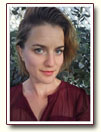 Hannah
Shepard studied writing at Sarah Lawrence College and received masterís degrees
from the National University of Ireland and Fordham, where she was a teaching
fellow and a Loomie Prize winner. Engaging with history, the arts, and social
justice, Hannah is drawn to projects that cross boundaries. She has worked as a
researcher, educator, and script reader with institutions including the New York
Public Library for the Performing Arts, the Museum of the City of New York, The
Public Theater and the Louie B. Nunn Center for Oral History. As an archival
researcher and producer, Hannah has worked with filmmakers including Rebecca
Miller, Nancy Buirski, and Catherine Gund. In 2019 she was nominated for the
FOCAL Jane Mercer Researcher of the Year Award. Her fiction has been published
by W.W. Norton, Fiction Southeast, and Spout Press. Hannah
Shepard studied writing at Sarah Lawrence College and received masterís degrees
from the National University of Ireland and Fordham, where she was a teaching
fellow and a Loomie Prize winner. Engaging with history, the arts, and social
justice, Hannah is drawn to projects that cross boundaries. She has worked as a
researcher, educator, and script reader with institutions including the New York
Public Library for the Performing Arts, the Museum of the City of New York, The
Public Theater and the Louie B. Nunn Center for Oral History. As an archival
researcher and producer, Hannah has worked with filmmakers including Rebecca
Miller, Nancy Buirski, and Catherine Gund. In 2019 she was nominated for the
FOCAL Jane Mercer Researcher of the Year Award. Her fiction has been published
by W.W. Norton, Fiction Southeast, and Spout Press.
Fordham's Loomie Prize was awarded to Hannah for her paper,
"Vanished in Plain Sight: Scots-Irish Presbyterians in Wisconsin, 1830-1890".
Her paper argues that Ulster Presbyterians brought their unique brand of
political and religious radicalism, with its roots in their Irish experience,
with them to Wisconsin, influencing the early character of a state which has
been known equally for its progressivism and its evangelicalism in the
nineteenth and twentieth centuries.
It appears that those excellent writing skills are in the
Shepard genes!
* * * * *
I came across this art board print of Sam by illustrator Paul
Cemmick. I don't see much resemblance except for his hair. The shirt says "Days
of Heaven" but the background shows him as Chuck Yeager coming out of the
flames. Personally, I don't think it blends very well.
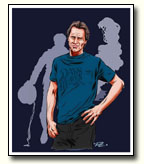
|
|
|
|
|
|